Memory Efficient Loss Recovery for Hardware-based
Author : min-jolicoeur | Published Date : 2025-05-10
Description: Memory Efficient Loss Recovery for Hardwarebased Transport in Datacenter Yuanwei Lu12 Guo Chen2 Zhenyuan Ruan12 Wencong Xiao23 Bojie Li12 Jiansong Zhang2 Yongqiang Xiong2 Peng Cheng2 Enhong Chen1 1USTC 2Microsoft Research
Presentation Embed Code
Download Presentation
Download
Presentation The PPT/PDF document
"Memory Efficient Loss Recovery for Hardware-based" is the property of its rightful owner.
Permission is granted to download and print the materials on this website for personal, non-commercial use only,
and to display it on your personal computer provided you do not modify the materials and that you retain all
copyright notices contained in the materials. By downloading content from our website, you accept the terms of
this agreement.
Transcript:Memory Efficient Loss Recovery for Hardware-based:
Memory Efficient Loss Recovery for Hardware-based Transport in Datacenter Yuanwei Lu1,2, Guo Chen2, Zhenyuan Ruan1,2, Wencong Xiao2,3, Bojie Li1,2, Jiansong Zhang2, Yongqiang Xiong2, Peng Cheng2, Enhong Chen1 1USTC, 2Microsoft Research, 3BUAA RDMA (RoCEv2) High throughput, low latency and zero-cpu overhead Go-back-N, PFC required Light-weight Transport Layer (LTL)[1] Inter-FPGA communication Go-back-N, PFC required Existing Hardware-based Transports [1] Adrian M Caulfield, et al. A cloud-scale acceleration architecture. MICRO 2016. Loss Sources Congestion loss: can be removed by PFC Failure loss: hard to be mitigated at large scale Statistics from real DCs A persistent 0.2% silent random drop which lasts for 2 days [2] Loss ratio of some network switch can be up to 2% [2] Loss is Not Uncommon in DCs [2] Chuanxiong Guo, et al. Pingmesh: A large-scale system for data center network latency measurement and analysis. ACM SIGCOMM 2015 Go-Back-N Tput drops to near zero when loss ratio is >0.1% Inefficient Loss Recovery SACK TCP: state of the art loss recovery Recover multiple losses within a sending window Performs well under even high packet loss ratio, e.g. 1% Question: can we extend selective retransmission to hardware-based transport? Answer: MELO Memory-Efficient LOss recovery Implements Selective Retransmission for hardware transport How can we do better? Hardware on-chip memory is limited On-chip memory is usually a cache for off-chip memory Swapping between on-chip and off-chip is expensive Challenges Figure borrowed from: Anuj Kalia, et al. Design Guidelines for High Performance RDMA Systems. ATC 2016 Loss recovery for hardware transport should be on-chip memory-efficient #1: Re-ordering buffer is required to store loss induced out-of-order data #2: Meta data is required for tracking out-of-order packets Extra Memory is Required The necessity of re-ordering buffer RDMA requires in-order message placement LTL requires in-order packet delivery Size of out-of-order data BDP: 100G * 100us ~ 1.25MB Too much for on-chip memory Challenge #1: Re-Ordering Buffer 5 4 2 1 3 X Flag 5 4 2 1 3 Read 3 ERROR A re-ordering buffer is required before placing out-of-order data into app buffer Ready Selective retransmission bitmap size BDP: 100G * 100us (1KB MTU) ~ 150B Too much for on-chip memory: Mellanox CX3 Pro NIC, per-connection transport states is 248B Challenge #2: Meta Data A per-connection bitmap would take too much on-chip memory Separate data and meta data storage Re-ordering buffer in off-chip memory Off-chip memory is large in size, usually GBs Meta data in on-chip memory














